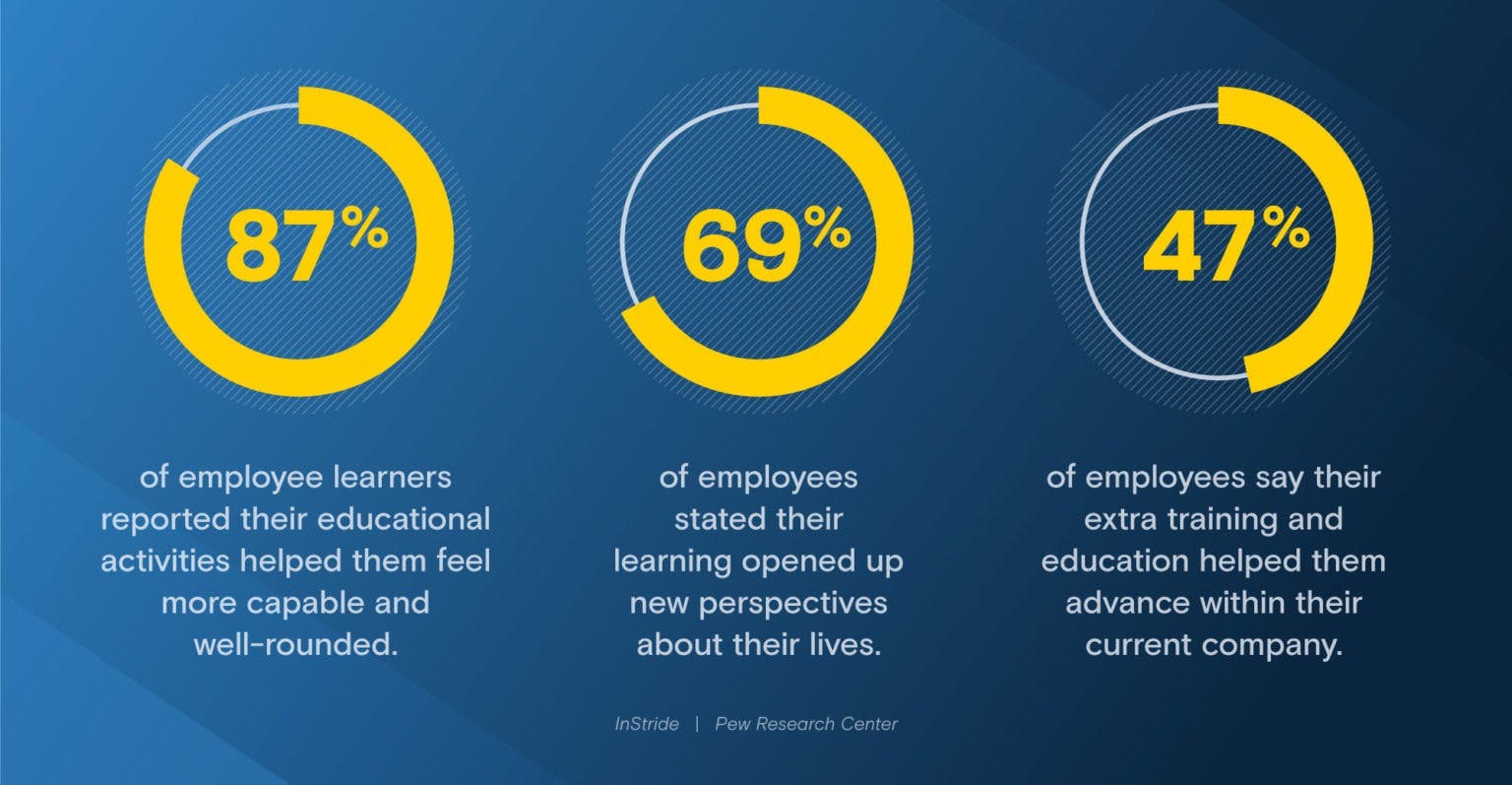Creating a culture of learning at work is not a new concept for HR leaders. However, there’s no question that it is still important. What is new are the ways you can modernize the approach to fostering a culture of learning at the workplace – one that keeps up with working adults evolving wants and needs, while aligning with overarching organizational goals.
What is a learning culture?
As it pertains to the workplace, the term learning culture refers to a work environment that prioritizes skills development and knowledge sharing as central to its values.
A strong corporate learning culture looks different at every business since no two companies are the same. However, they all have this in common: the employees not only want to learn and apply what they’ve learned to help their organization, but they also feel compelled to share their knowledge with others.
So, it's important for executives to consider why learning is important to their organization and start to build a culture based on those values.
Benefits of a workplace learning culture
Research reveals that developing a healthy learning culture leads to more committed employees and improves overall company performance. A recent report showed 94 percent of employees said investment in training and education is one of the major reasons they would decide to stay in a role for longer. Additionally, research by Bersin showed that those companies with workforces that have the desire to learn are at least 30 percent more likely to be market leaders in their industries over an extended period of time.
A robust learning culture can also break down social and economic barriers, drive talent development and bridge skills gaps.
So with all that, it just makes sense to keep updated on fresh ways to foster a dynamic, thriving learning culture within your organization.
Tips for promoting a culture of learning in the workplace
Encourage two-way knowledge sharing
Knowledge sharing is key for developing a learning culture, and it’s especially effective when it’s reciprocal. In other words, when employees are encouraged and recognized for sharing their own knowledge, they will be more engaged in learning from others as well.
Though prospective employee learners need practical information to influence their decisions, such as costs, duration and outcomes, they also rely on others’ shared stories to overcome emotions such as fear of failure and concerns about time constraints. Knowledge sharing is a form of roleplaying that can provide learners with insights about what learning will be like for them, and how their lives will be different and improved by pursuing education opportunities.
Commit to skill-building
In today’s environment, a company’s commitment to skill building is particularly relevant and sharply highlighted in data. Compared to pre-pandemic figures, more than one-third of workers feel less confident they have the skills to do their jobs well.
Research also shows that 57 percent of workers wish they had more up-to-date skills and 69 percent believe the pandemic will permanently change work. Another 46 percent of workers said if their employers didn't offer them opportunities to upskill, they were likely to leave their job. Among all this uncertainty, here’s what you should do — make skill-building a priority and invest in your people. Again, the numbers highlight the benefits.

Celebrate learning successes and milestones
Acknowledgment is important. Employees appreciate recognition for the time and energy they’ve invested in their learning. So, find ways to show your people that your company values the hard work they put into learning. These can include implementing organization-wide initiatives that reward your employees for their learning efforts and accomplishments.
Rewards can range from a shout-out at a company meeting, in an email or on Slack, to an award or prize for the employee with the most learning courses completed over a set period of time.
Secure the support of a C-suite champion and managers
Here’s a powerful statistic — 90 percent of companies with strong learning cultures have senior executives actively engaged in L&D initiatives. However, only 34% of learners have an executive team that encourages them to learn.
So, this opportunity gap is worth exploring. The power of managers should also not be underestimated. This is the top way L&D pros are helping build a culture of learning — including people managers in driving employee learning and skill development.
Create accessible, customized learning pathways
Learning pathways make training and education more relevant and meaningful to your employees. By setting learning goals and developing an employee development plan to achieve them, your employees will be more engaged in the process of learning.
A major shift in workforce education is that it’s no longer just about completing an individual course. A more significant impact is achieved with a strategic approach to customizing education paths for your employees and helping them reach their short- and long-term career goals.
Get the word out and keep everyone informed
If employees don't know about workforce employee opportunities, they aren't going to participate. Case in point, U.S. companies spend $28 billion on education programs every year. Yet only 40 percent knew their employer offered a program and 2 percent of employees actually use their employer’s tuition assistance programs.
This is where a workforce education program that encompasses a solid communications component comes into play. Build awareness and engagement of training and development offerings by launching marketing campaigns that include multiple communications channels such as employee newsletters, emails, in-person meetings and Slack. Also, understanding the value and outcomes of learning is a significant motivator, so let your employees know what's in it for them.
Take a more strategic approach to workforce education
A strategic approach to workforce education is a game-changer for building a strong learning culture. In the constantly changing workplace, education is key to learning new skills that enable your employees to stay productive and effective. This value extends to a company’s performance as well.
Focusing on the value of employee talent development showed that 84 percent of employees within the best-performing organizations are receiving the training and education they need compared with 16 percent in the worst-performing companies.
The takeaway: A workplace learning culture is beneficial for all
As you can see, a strong workplace learning culture has a myriad of benefits. From increased employee engagement to skills development and improved retention, there are countless reasons why every business should consider continuous learning as integral to its company culture.
Fostering a learning environment within your organization starts with understanding your employees and their needs. To access original insights and learn what employees really want out of workplace L&D, unlock this report.

